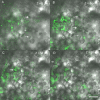Bacterial spot of tomato and pepper: diverse Xanthomonas species with a wide variety of virulence factors posing a worldwide challenge
- PMID: 25649754
- PMCID: PMC6638463
- DOI: 10.1111/mpp.12244
Bacterial spot of tomato and pepper: diverse Xanthomonas species with a wide variety of virulence factors posing a worldwide challenge
Abstract
Taxonomic status: Bacteria; Phylum Proteobacteria; Class Gammaproteobacteria; Order Xanthomonadales; Family Xanthomonadaceae; Genus Xanthomonas; Species Xanthomonas euvesicatoria, Xanthomonas vesicatoria, Xanthomonas perforans and Xanthomonas gardneri.
Microbiological properties: Gram-negative, rod-shaped bacterium, aerobic, motile, single polar flagellum.
Host range: Causes bacterial spot disease on plants belonging to the Solanaceae family, primarily tomato (Solanum lycopersicum), pepper (Capsicum annuum) and chilli peppers (Capsicum frutescens).
Disease symptoms: Necrotic lesions on all above-ground plant parts.
Distribution: Worldwide distribution of X. euvesicatoria and X. vesicatoria on tomato and pepper; X. perforans and X. gardneri increasingly being isolated from the USA, Canada, South America, Africa and Europe. A wide diversity within the bacterial spot disease complex, with an ability to cause disease at different temperatures, makes this pathogen group a worldwide threat to tomato and pepper production. Recent advances in genome analyses have revealed the evolution of the pathogen with a plethora of novel virulence factors. Current management strategies rely on the use of various chemical control strategies and sanitary measures to minimize pathogen spread through contaminated seed. Chemical control strategies have been a challenge because of resistance by the pathogen. Breeding programmes have been successful in developing commercial lines with hypersensitive and quantitative resistance. However, durability of resistance has been elusive. Recently, a transgenic approach has resulted in the development of tomato genotypes with significant levels of resistance and improved yield that hold promise. In this article, we discuss the current taxonomic status, distribution of the four species, knowledge of virulence factors, detection methods and strategies for disease control with possible directions for future research.
Keywords: Xanthomonas; bacterial spot; pepper; tomato.
© 2015 BSPP AND JOHN WILEY & SONS LTD.
Figures





References
-
- Almeida, N.F. , Yan, S. , Cai, R. , Clarke, C.R. , Morris, C.E. , Schaad, N.W. , Schuenzel, E.L. , Lacy, G.H. , Sun, X. and Jones, J.B. (2010) PAMDB, a multilocus sequence typing and analysis database and website for plant‐associated microbes. Phytopathology, 100, 208–215. - PubMed
-
- Araújo, E.R. , Pereira, R.C. , Moita, A.W. , Ferreira, M.A.S.V. , Café‐Fiho, A.C. and Quezado‐Duval, A.M. (2010) Effect of temperature on pathogenicity components of tomato bacterial spot and competition between Xanthomonas perforans and X. gardneri. III International symposium on tomato diseases. Acta Hort. 914, 39–42.
-
- Araújo, E.R. , Costa, J.R. , Ferreira, M.A.S.V. and Quezado‐Duval, A.M. (2012) Simultaneous detection and identification of the Xanthomonas species complex associated with tomato bacterial spot using species‐specific primers and multiplex PCR. J. Appl. Microbiol. 113, 1479–1490. - PubMed
-
- Astua‐Monge, G. , Minsavage, G.V. , Stall, R.E. , Davis, M.J. , Bonas, U. and Jones, J.B. (2000a) Resistance of tomato and pepper to T3 strains of Xanthomonas campestris pv. vesicatoria is specified by a plant‐inducible avirulence gene. Mol. Plant–Microbe Interact. 13, 911–921. - PubMed
-
- Astua‐Monge, G. , Minsavage, G.V. , Stall, R.E. , Vallejos, C.E. , Davis, M.J. and Jones, J.B. (2000b) Xv4–vrxv4: a new gene‐for‐gene interaction identified between Xanthomonas campestris pv. vesicatoria race T3 and the wild tomato relative Lycopersicon pennellii . Mol. Plant–Microbe Interact. 13, 1346–1355. - PubMed
MeSH terms
Substances
LinkOut - more resources
Full Text Sources
Other Literature Sources

